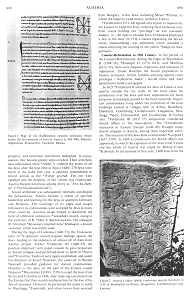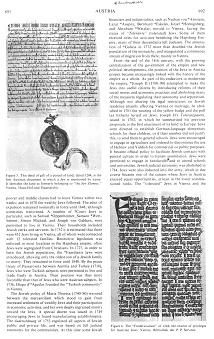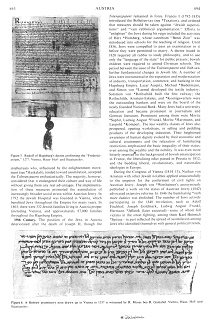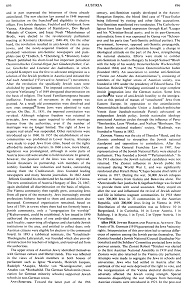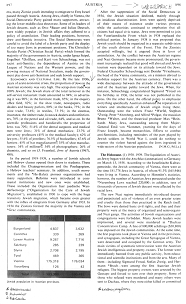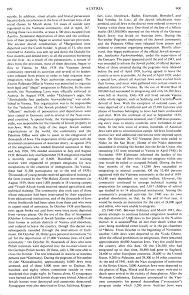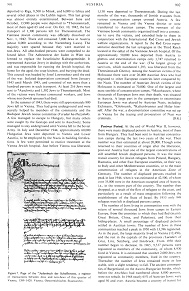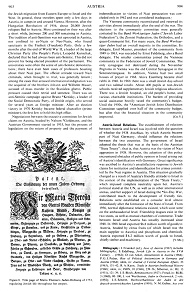<Counter-Reformation to 19th Century.
In the period of the Counter-Reformation, during the
reigns of Maximilian II (1564-76), *Rudolph II
(1576-1612), and Matthias (1612-19), there were frequent
expulsions and instances of oppression.
[Protected Jews under
Ferdinand II]
Under Rudolph the Jewish population in Vienna increased;
certain families enjoying special court privileges
("hofbefreite Juden") [["Jews liberated by the court"]]
moved there and were permitted to build a synagogue.
In 1621 *Ferdinand II allotted the Jews of Vienna a new
quarter outside the city walls. In the rural areas the
jurisdiction over the Jews and their exploitation for
fiscal purposes increasingly passed to the local
overlords. Important communities living under the
protection of the local lordships existed in villages
such as Achau, Bockfliess, Ebenfurth, Gobelsburg,
Grafenwoerth, Langenlois, Marchegg, *Spitz,
Tribuswinkel, and Zwoelfaxing.
In Vienna also, *Ferdinand III (1637-57) temporarily
transferred Jewish affairs to the municipality. The
*Chmielnicki massacres in Eastern Europe (1648-49)
brought many Jewish refugees to Austria, among them
important scholars.
[Expulsion of the Jews
from Vienna under Leopold I]
The situation of the Jews deteriorated under *Leopold I
(1657-1705). In 1669 a commission for Jewish affairs was
appointed, in which the expulsion of the Jews from
Vienna and the whole of Austria was urged by Bishop
Count *Kollonch. In the summer of that year, 1,600 Jews
from the (col. 890)
poorer and middle classes had to leave Vienna within two
weeks; and in 1670 the wealthy Jews followed. The edict
of expulsion remained nominally in force until 1848,
although sometimes transvened.
A number of *Court Jews in particular, such as Samuel
*Oppenheimer, Samson *Wertheimer, Simon Michael, and
Joseph von Geldern, were permitted to live in Vienna.
Their households included Jewish clerks and servants. In
1752 it is estimated that there were 452 Jews living in
Vienna, all of whom were connected with 12 tolerated
families.
[18th century until
1848: Discrimination of Jews by segregation, by
marriage laws - Turkish Jews since 1718]
Restrictive legislation was enforced in most localities
in the Hapsburg empire; often Jews were segregated from
Christians. In 1727, in order to limit the Jewish
population, the *Familiants laws were introduced,
allowing only the oldest son of a Jewish family to
marry. They remained in force until 1848. By the peace
treaty of Passarowitz between Austria and Turkey (1718),
Jews who were Turkish subjects were permitted to live
and trade freely in Austria. Their position was thus
more favorable than that of Jews who were Austrian
subjects. In 1736, Diego d'*Aguilar founded the "Turkish
community" in Vienna.
Jewish order of Maria
Theresa, 1753
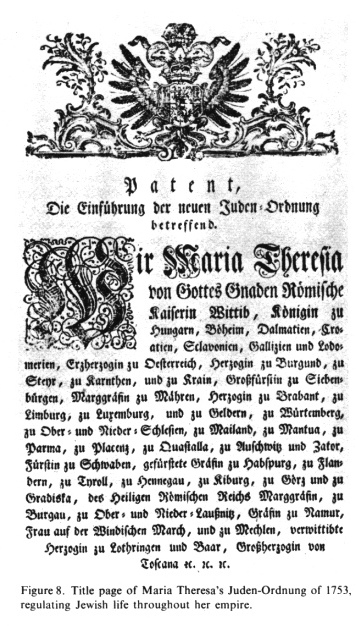
Encyclopaedia Judaica: Austria, vol.3, col.903:
Jewish order 1753: Title page of Maria Theresa's
Jewish Order ("Judenordnung") of 1753, regulating
Jewish life throughout her empire. |
[Jews as "useful
citizens" under Joseph II]
From the end of the 18th century, with the growing
centralization of the government of the empire and new
political developments, the position of the Jews in
Austria proper became increasingly linked with the
history of the empire as a whole. As part of his
endeavors to modernize the empire, *Joseph II (1780-90)
attempted to make the Jews into useful citizens by
introducing reforms of their social mores and economic
practices and abolishing many of the measures regulating
their autonomy and separatism.
Although not altering the legal restrictions on Jewish
residence (mainly affecting Vienna) or marriage, he
abolished in 1781 the wearing of the yellow badge and
the poll tax hitherto levied on Jews.
[1782: The
Toleranzpatent - Jews between assimilation and
cultural identification]
Joseph II's Toleranzpatent
[[law of tolerance]], issued in 1782, in which he
summarized his previous proposals, is the first
enactment of its kind in Europe. Jews were directed to
establish German-language elementary schools for their
children, or if their number did not justify this, to
send them to general schools. Jews were encouraged to
engage in agriculture and ordered to discontinue the use
of Hebrew and Yiddish for commercial or public purposes.
It became official policy to facilitate Jewish contacts
with general culture in order to hasten assimilation.
Jews were permitted to engage in handicrafts and to
attend schools and universities. Jewish judicial
autonomy was abolished in 1784. Jews were also inducted
into the army, which in due course became one of the
careers where Jews in Austria enjoyed equal
opportunities, at least in the lower commissioned ranks.
The "tolerated" Jews in Vienna and the (col. 892)
intellectuals who, influenced by the enlightenment
movement (see *Haskalah), tended toward assimilation,
accepted the Toleranzpatent
enthusiastically. The majority, however, considered that
it endangered their culture and way of life without
giving them any real advantages. The implementation of
these measures promoted the assimilation of increasingly
broader social strata within Austrian Jewry. In 1792 the
Jewish Hospital was founded in Vienna, which benefited
Jews throughout the Empire for many years. In 1803,
there were 332 Jewish families living in Austria proper
(including Vienna), and approximately 87,000 families
throughout the Hapsburg Empire.> (col. 893)



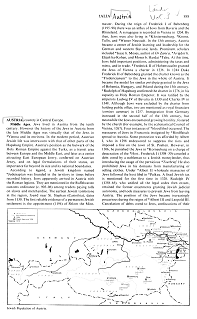
 Encyclopaedia
Judaica
1971: Austria, vol. 3, col. 887-888
Encyclopaedia
Judaica
1971: Austria, vol. 3, col. 887-888